Running Shoe Guide 1: What To Do When Your New Running Shoes Arrive
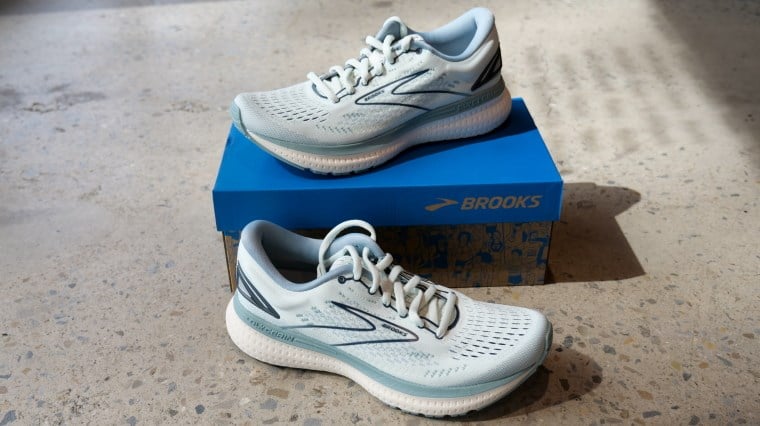
Well done! With your purchase of new running shoes from Sportitude Running, you’ve taken the first step on your running journey to run stronger, faster or further in comfort. Whether you’re a new runner or an elite athlete with your sights set on the winner’s podium, the best running shoes are only as good as the fit they provide for you, the runner.
We guide you through the fitting process - from unboxing and lacing up, to testing your running shoes at home to ensure you’ve found your perfect running companion.
Unboxing
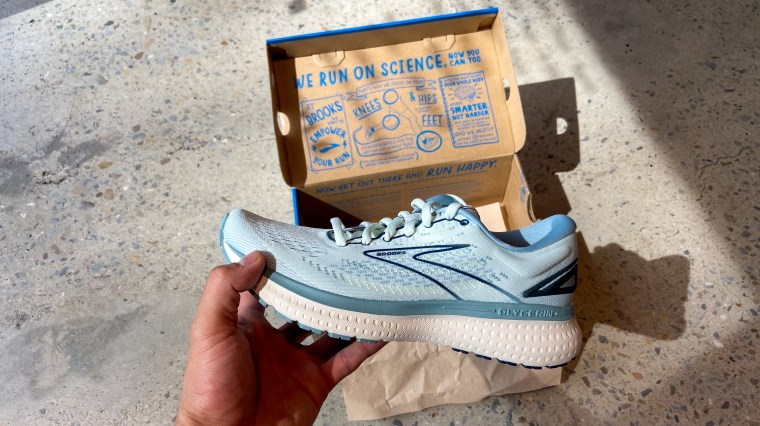
First things first, carefully unbox your new running shoes. It’s important to keep the shoe box and running shoes in original saleable condition. This means leaving on any labels and avoiding any damage to the box, so both running shoes and packaging remain in a new condition - just in case you need to use our 30 day returns and exchanges policy.
Check Size
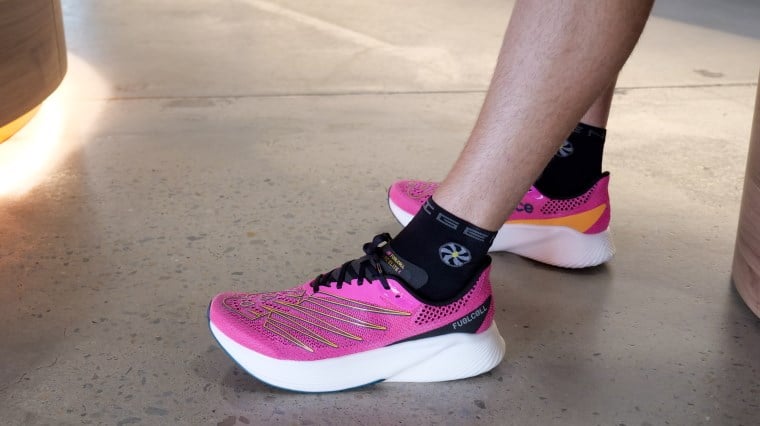
In terms of testing your running shoes for the right feel, first impressions matter.
The size of your running shoes (the number from US 5 – US 13 for women or US 7 – US 16 for men) is based on the length of your feet measured in cm. Many common running injuries to the feet can be solved by having the correct size from heel-to-toe.
While wearing your running socks, try on your new running shoes indoors to gain a first step-in feel. Every runner has a preferred fit – some opt for a tighter, snugger hold on the foot and others prefer a roomier, more relaxed fit.
Once the running shoes are secure on your feet, test the fit while standing with feet shoulder width apart as this will indicate the shape and size of your feet when they are weight-bearing.
Forefoot Fit
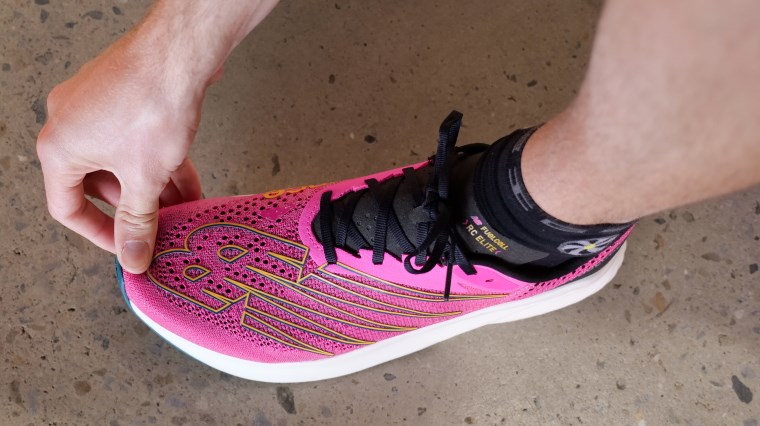
As a general guideline, a proper running shoe fit should leave half to a full thumb’s width between the end of your longest toe and the end of the running shoe. This provides ‘wriggle room’ in the toe box, allowing your toes to splay for natural shock absorption on footstrike, and engage fully to propel your ride forward on toe-off.
Your forefoot expands naturally during your running workouts due to increased blood circulation stimulated by activity – particularly when endurance running. Therefore, an accommodating forefoot fit will also prevent problems associated with tight, ill-fitting shoes mid-run, such as repetitive trauma to toenails being pressed against the front of the shoe.
However, a forefoot fit that is too loose or deep can make the running shoe feel ‘boxy’, clunky or heavy on the foot. To move comfortably and efficiently, it’s important to find your ‘sweet spot’ regarding your shoe sizing.
Heel Fit
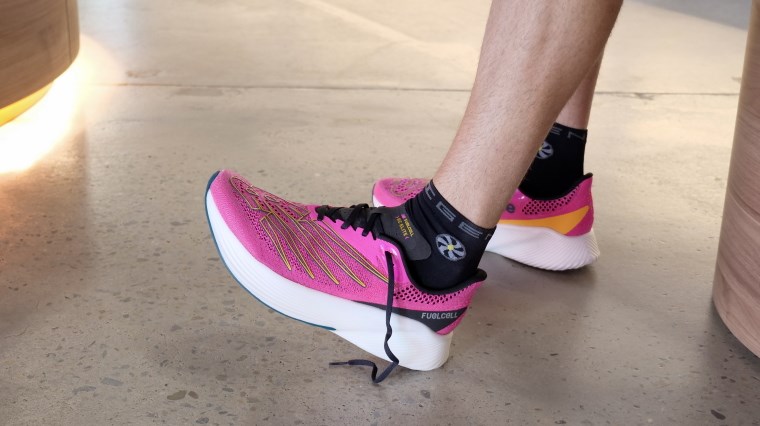
The heel counter of the running shoe should hug snugly to your rearfoot to prevent heel slippage – which can be just as painful as it is distracting if this friction results in blisters and skin irritation. With the running shoe, tap the end of your heel against the floor before you lace up to ensure your foot is as far back in the shoe as it can go. This will also allow you to ascertain the length in the toe box.
Now is the perfect time to achieve correct lace tension for a stay-put fit. Based on your preference, you may prefer a runner's heel lock lace over standard lacing. The advantage of a runner’s heel lock lace is that it provides extra security - locking the heel in place like a seatbelt. This lacing tip from our running shoe experts allows you to say goodbye to heel slippage and hello to a distraction-free run.
Wearing high quality running socks is another way of ensuring your heels don’t slip in your shoes. We'll discuss the importance of your running sock selection in more detail below.
Check Width
You not only should be looking at the size or length of the shoe – the width is just as important.
The width of feet varies widely between runners, and top-of-the-line brands release multiple widths in their premium running shoes to cater to a greater variety of foot types – from narrow to extra wide - which we love and tip our hat to.
The widest part of your foot can be measured from the first metatarsal to the fifth metatarsal, just underneath the toes across the ball of the foot.
If you feel tightness at the arch region or pressure on the sides of your feet, this may suggest you need to go up a width. Your foot should be fully supported by and not overlapping the platform of the shoe. The upper material on the medial and lateral side shouldn’t bulge to accommodate the broadness of your feet.
Alternatively, if the running shoes feel ‘wobbly’ on your foot from side to side, this may mean a narrower width would be right for you.
Women’s running shoe widths:
- 2A width: Narrow (limited offering)
- B width: Standard
- D width: Wide
- 2E width: Extra Wide
Men’s running shoe widths:
- B width: Narrow (limited offering)
- D width: Standard
- 2E width: Wide
- 4E width: Extra wide
Test your new running shoes indoors
Your running shoes are for exactly that – running (or jogging/walking at your preferred pace or until you gain more confidence to set a faster pace) – so testing them while standing may tick off some elements of being the right fit, but you won’t really know until you literally lift your feet up and get moving in them.
To put your running shoes to the test while keeping them in a new condition (in case they don’t fit quite right) lace them to your desired tension with your favourite pair of running socks and walk inside your house. Don’t test them outdoors or on abrasive surfaces as this may scuff the soles and make them unreturnable.
Walk the length of your home, up and down the stairs or jog on the spot to get a feel of your new running shoes. Look out for any heel slippage, soreness, pressure spots, rubbing or tightness where there shouldn’t be.
Consider trying them on at the end of the day. Your foot will be slightly swollen from gravity taking its course through the day, so this will give you a good indication to how the shoe will fit during exercise, when your foot naturally swells.
Also consider the alignment of your body, as your running shoes not only affect your feet but your ankles, knee joint and hips. If you’re comfortable moving in them and feel you have the right degree of cushioning and support for your foot type and they are staying in place on the foot, you’ve found your ideal fit.
Other considerations
Running shoe function: Racing/tempo shoes vs high mileage shoes

When considering fit, keep in mind the specific purpose of the running shoes. Running shoes for racing and tempo/interval sessions where you’ll shift the pace up a gear are designed for a snugger, close-to-foot fit. They ensure your feet and running shoe move in harmony, as if the shoe is an extension of your body.
A racing fit can create a barely-there feel that enhances your connection to your running shoes and your proprioception (the awareness of your limb placement). Manufacturers of racing shoes often pair this sock-like fit with just-right protection and responsiveness you need to accelerate explosively and maintain that speed.
Try not to make the mistake of choosing a smaller racing shoe size to cut down on weight – shedding a few grams is unlikely to make a difference to your race time in the long run, whereas your comfort will make all the difference to your performance.
On the other hand (or foot), a more relaxed fit at the forefoot can boost air circulation and is suitable for high-mileage running shoes used for longer, easy-going runs. The running shoes should still remain snug in the right places like heel and midfoot, without feeling overly tight or restrictive.
New running shoes are not supposed to hurt
Chances are your running shoes may require a wear-in period for the padding to mould more comfortably to your feet and for your feet to grow accustomed to them until they feel natural - particularly if the heel-to-toe offset and stack height is a gradual jump up or down from what you’re used to.
New running shoes are not supposed to hurt – whether it’s irritation to your skin like blisters or body alignment issues associated with heel pain, ankle pain, hip pain or back pain.
Running shoes that are too tight can potentially restrict blood flow. Don’t rely on the upper material stretching. Size up instead or consider a different running shoe model if you’re feeling pressure points, discomfort, squashed or suffocated inside the shoes from the first step-in.
Any irritation or pain on first step-in is an immediate warning sign that the running shoes are not right for you.
Your running socks can change the feel and fit
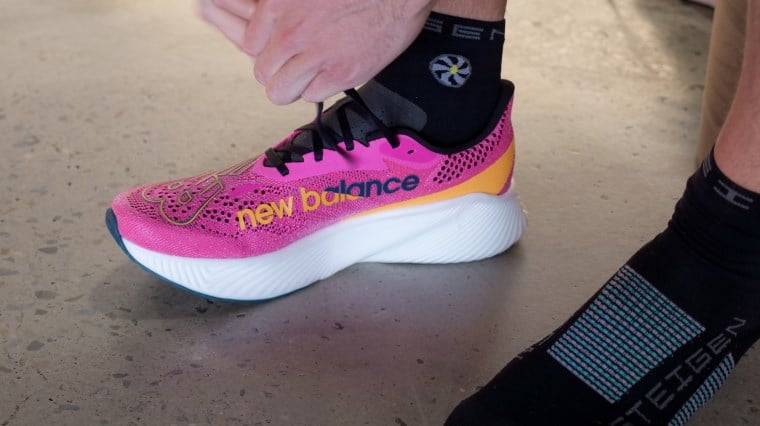
Although you want the right fit of running shoes from the get-go, the type of technical running socks you choose can greatly influence how your shoe fits, prevent blisters or even help adapt the fit to conform better with your foot size and shape.
Although we’d never recommend style or colour being the first or most prominent factor to consider in your shoe selection (comfort, comfort and comfort!), you may be loyal to a particular brand or model and not wish to shift to a new one, even if the fit isn’t as you expected straight out-of-the-box.
If you're wearing a more voluminous or roomy shoe, you may benefit from a thicker running sock like Lightfeet running socks to help ‘pad out’ the excess space and add plushness at the toe and heel.
If you're wearing a snugger running shoe you may prefer a thinner sock like Steigen running socks (shown above) that offer a feel like running barefoot. This allows the cushioning or stability technologies of your new running shoes to really shine, uncompromised by excess fabric inside the shoe.
Inconsistent shoe sizing from brand to brand
Don’t rely on size to be consistent from brand to brand, or within a brand. Even the sizing of shoes from the same running shoe family can vary from generation to generation. This is one of the reasons it’s so important to try your running shoe indoors prior to taking them to the pavement.
Your foot size may expand during the day
As we touched on previously, you may find your new running shoes fit slightly differently first thing in the morning than they do in the afternoon or evening. Your feet naturally swell during activity, so it’s best to consider the fit of your running shoes when your feet are at their largest (towards the end of the day) to ensure the fit is comfortable and accommodating.
Your shoe size may change during your adult life
Even as an adult your shoe size may change during different stages of your life. Particularly during pregnancy and post-birth your feet expand, and you may need to consider going up a size or width.
Happy running!
If you liked this, then you’ll love:
Running Shoe Guide 2: How To Break In Your New Running Shoes
Running Shoe Guide 3: How To Clean And Care For Your New Running Shoes
